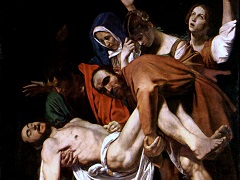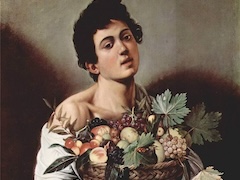Amor Victorious, 1602 by Caravaggio

Cupid, the god of love stand upon the trampled symbols of music, science, war, and government, illustrating Virgil's line: "love conquers all; let us all yield to love!" Caravaggio's depiction of Cupid, rather than the cherub-like,
idealized boy, is realistic, from the crooked grin to the tousled head of hair. The painting was commissioned by a rich patron Vincenzo Guistanini, who retained it in his possession and reportedly loved it above all others. The
painting was an immediate success, and inspired contemporary artworks, including poems and epigrams along the same theme.
In this painting, the boy is knowing and insolent, rather than heroic or ideal. His pose seems to derive from Victory by Michelangelo,
but unlike that precarious hero, he is firmly in the saddle. He is triumphant over the intellectual life: music (the old-style lute, the new Cremonese violin, and the score, with the incipit beginning with V, perhaps for Vincenzo),
geometry (the T square and compass), and astronomy (the blue globe with stars), three parts of the scholastic formula of the quadrivium.
The subtlety of the painting is not limited to the theme. The left background is strangely incomplete, with incomprehensible marks above the musical instruments, as if Caravaggio had carelessly rubbed the pigment off his brushes
there. But the modulation between warm and cool neutrals in the upper and the right backgrounds makes clear that he lavished attention on it. Furthermore, the lack of any division between wall and floor seems to remind us that the
figure and the objects are illusory, materializing from the canvas rather than from the room, as the painter's creations rather than as actuality. The disproportion between the short right arm, the long legs, and the large head
and the short, but well-developed, torso suggests that Caravaggio was deliberately utilizing the forms as well as the pose of the Victory. Thus it may be that he did introduce into the painting references to painting and sculpture,
but as love's creators, rather than his victims.
















